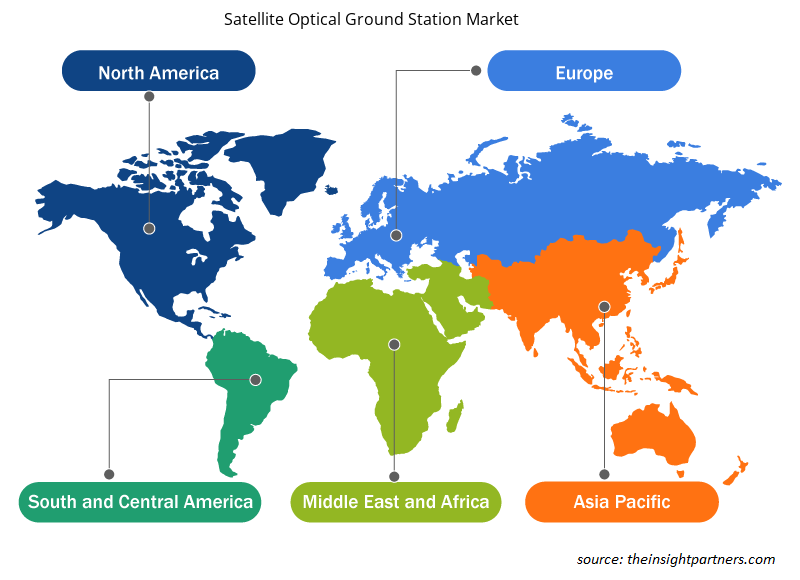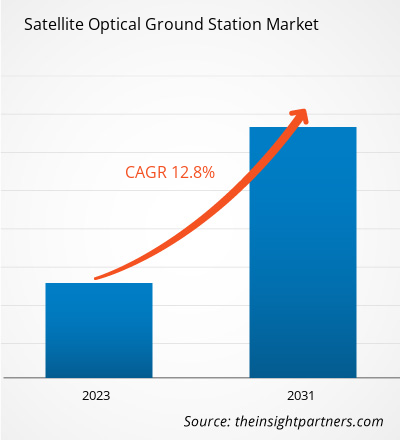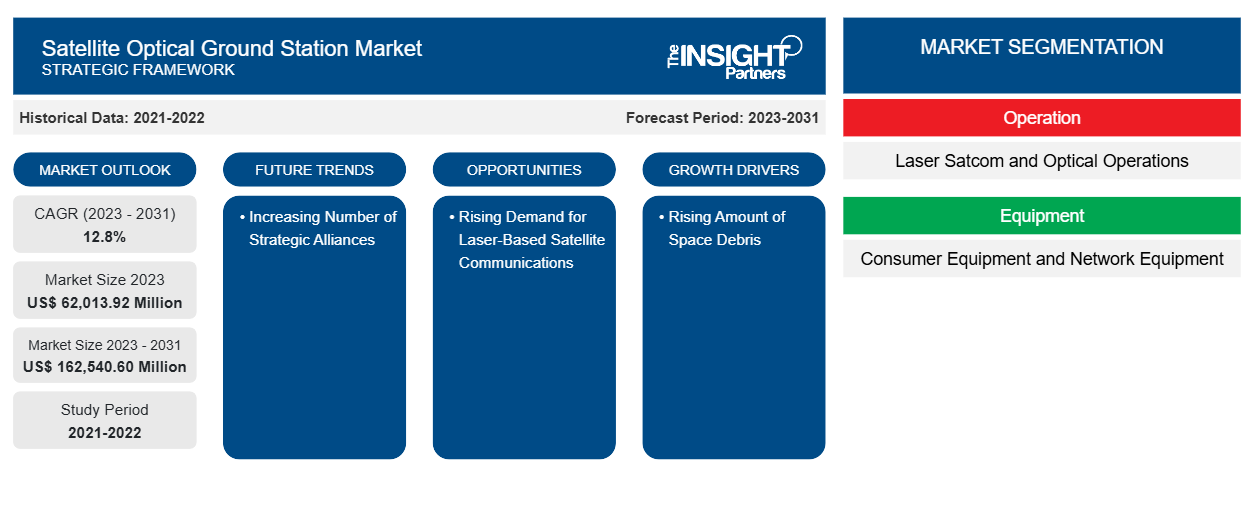Si prevede che la dimensione del mercato delle stazioni ottiche terrestri satellitari raggiungerà i 162.540,60 milioni di dollari entro il 2031, rispetto ai 62.013,92 milioni di dollari del 2023. L'aumento della costruzione di nuovi aeroporti in tutto il mondo sta contribuendo all'aumento della domanda di soluzioni di rete di comunicazione. Il crescente numero di lanci satellitari a livello globale sta stimolando la domanda di stazioni ottiche terrestri per tracciare e monitorare il movimento dei satelliti e ricevere e trasmettere dati simultaneamente. Inoltre, gli OGS avanzati stanno raccogliendo la domanda per il loro aiuto nel monitoraggio di questi satelliti. Inoltre, la domanda di OGS sta spingendo per evitare la minaccia di collisione di detriti spaziali con risorse spaziali funzionali. Gli OGS aiutano anche a garantire attività spaziali sicure e sostenibili conformi alle linee guida, agli standard e ad altre norme nazionali e internazionali.
Analisi del mercato delle stazioni ottiche terrestri satellitari
Il numero di lanci di satelliti sta aumentando a livello globale a causa della crescente necessità di satelliti in varie applicazioni come l'osservazione della Terra, la comunicazione e la navigazione e la ricerca scientifica. Secondo diverse agenzie spaziali, in media, sono stati lanciati circa 466 SmallSat all'anno nel periodo 2012-2021 e si prevede che tale numero aumenterà a 1.846 lanci di SmallSat all'anno nel periodo 2022-2031. Per il lancio di questi 4.663 SmallSat nel periodo 2012-2021, i governi di vari paesi e aziende hanno investito circa 23,1 miliardi di dollari USA e si prevede che investiranno altri 84 miliardi di dollari USA nel periodo 2022-2031. Inoltre, anche il numero di lanci di razzi spaziali , principalmente per il dispiegamento di satelliti nello spazio, sta aumentando rapidamente. Nel 2021, ci sono stati 136 lanci di razzi di successo, mentre nel 2022, il numero è salito a 180. A settembre 2022, si è visto che hanno avuto luogo 16 lanci orbitali, di cui 8 in Cina, 6 nelle Americhe e uno ciascuno in Europa e Russia. Inoltre, Falcon 9 ha lanciato 191 satelliti a banda larga Starlink e SpaceX ha lanciato 1.465 satelliti Starlink nel 2022. Di nuovo, a gennaio 2023, la Cina ha lanciato 14 satelliti in cima a un razzo vettore Long March-2D dal Taiyuan Satellite Launch Center nella provincia settentrionale cinese dello Shanxi. I 14 satelliti includevano Qilu-2 e Qilu-3, Luojia-3 01 e Jilin-1 Gaofen 03D34. A febbraio 2023, l'Indian Space Research Organisation (ISRO) ha annunciato il dispiegamento con successo di tre satelliti nelle orbite previste tramite il veicolo SSLV-D2.
Panoramica del mercato delle stazioni ottiche terrestri satellitari
Una stazione ottica di terra (OGS) è una parte essenziale dell'infrastruttura che collega lo spazio alla terra. Il sistema aiuta a fornire comunicazioni in tempo reale per varie applicazioni a velocità di trasmissione dati molto più elevate (fino a diversi Gbps) rispetto alla RF. La crescente necessità di dati ad alta risoluzione per missioni che richiedono agli scienziati di dare un'occhiata dettagliata alla Terra e al sistema solare si traduce in un'elevata domanda di sistemi OGS. Il sistema aiuta anche a fornire grandi volumi di dati per soddisfare i requisiti della missione e localizzare le risorse di terra relative ai parametri orbitali della missione. Pertanto, la domanda di OGS sta aumentando a livello globale per una maggiore accuratezza e un trasferimento dati ad alta velocità.
Personalizza questo report in base alle tue esigenze
Riceverai la personalizzazione gratuita di qualsiasi report, comprese parti di questo report, o analisi a livello nazionale, pacchetto dati Excel, oltre a usufruire di grandi offerte e sconti per start-up e università
-
Scopri le principali tendenze di mercato in questo rapporto.Questo campione GRATUITO includerà analisi di dati che spaziano dalle tendenze di mercato alle stime e alle previsioni.
Driver e opportunità del mercato delle stazioni ottiche satellitari di terra
Aumento della quantità di detriti spaziali
Tutti i materiali artificiali non funzionali che orbitano attorno alla Terra a diverse altitudini possono essere definiti detriti spaziali. I detriti includono parti del corpo del razzo, detriti di frammentazione, rifiuti creati durante le missioni con equipaggio, prodotti di scarico dei razzi e satelliti inutilizzati. La maggior parte di tali detriti orbita attorno alla Terra a una velocità media superiore a 26.000 km orari in orbite terrestri basse (LEO), rappresentando una grave minaccia di collisione per le risorse spaziali funzionali. Tali minacce aumentano con ogni lancio di razzo per LEO e spazio profondo. Le crescenti minacce di collisione di oggetti spaziali sono un problema persistente per l'uso sicuro e sostenibile dello spazio esterno. Queste minacce limitano l'accesso senza ostacoli allo spazio e spingono le parti interessate ad adottare le misure necessarie per mitigare il rischio. Nel novembre 2021, l'esercito russo ha condotto un test anti-satellite (ASAT) e ha fatto esplodere il suo satellite Cosmos 1408 inutilizzato (lanciato nel 1982) con un missile Nudol. Subito dopo l'esplosione, gli astronauti americani e russi a bordo della Stazione Spaziale Internazionale hanno dovuto adottare misure preventive per evitare di essere colpiti dai detriti del satellite, poiché la Stazione Spaziale Internazionale era presumibilmente abbastanza vicina al satellite. A giugno 2022, la Stazione Spaziale Internazionale ha dovuto nuovamente intraprendere una manovra anticollisione (CAM) per evitare i detriti orbitali del satellite distrutto. Una nave cargo Progress 81 senza equipaggio è stata utilizzata dall'agenzia spaziale russa Roscosmos per spostare la stazione spaziale dal percorso dei detriti. Nel 2021, l'ISRO ha eseguito 19 CAM, rispetto alle 12 e alle 8 CAM rispettivamente nel 2020 e nel 2019.
Numero crescente di alleanze strategiche
La crescente domanda di stazioni terrestri ottiche satellitari incoraggia le aziende a sviluppare soluzioni avanzate per l'espansione dell'industria spaziale . Per questa espansione, i governi di diversi paesi e le parti interessate in tutti i settori verticali dell'industria investono continuamente in R&S. Preferiscono varie alleanze strategiche, come partnership, collaborazioni e contratti, alcuni dei quali sono menzionati di seguito:
• A marzo 2023, CONTEC ha annunciato di aver scelto Cailabs per la fornitura di una stazione di terra ottica che verrà installata nel 2024. Questa nuova stazione di terra ottica incorporerà il componente TILBA-ATMO per comunicazioni affidabili e ad alta velocità. Inoltre, la stazione di terra sarà compatibile con CCSDS, SDA e QKD.
• A febbraio 2023, la Rwanda Space Agency (RSA) ha annunciato una partnership con ATLAS Space Operations Inc. per costruire un'infrastruttura satellitare terrestre in Ruanda. In base a questo accordo, la RSA sta costruendo un teleporto in grado di ospitare più stazioni terrestri per servire satelliti in orbite diverse.
• A settembre 2022, Safran Data Systems ha annunciato di aver firmato un contratto con CONTEC per la fornitura di una stazione ottica di terra che verrà installata nell'Australia Occidentale. Safran consegnerà una stazione ottica di terra (OGS) chiavi in mano, che consisterà in una montatura che offre una copertura ottimale; un telescopio da 50 cm; un sistema completo di puntamento, acquisizione e tracciamento; e una cupola rotante.OGS), which will consist of a mount offering optimal coverage; a 50-cm telescope; a complete pointing, acquisition, and tracking system; and a rotating dome.
• A settembre 2022, SSC ha annunciato che l'Agenzia spaziale europea (ESA) gli aveva assegnato un contratto da 1,09 milioni di dollari USA (1,1 milioni di euro) per supportare lo sviluppo del progetto di comunicazione ottica Network of Optical Stations for Data Transfer to Earth from Space (NODES). In base a questo contratto, SSC ha effettuato un ordine con Cailabs per la consegna di una stazione di terra nell'Australia occidentale, le cui prove dovrebbero iniziare all'inizio del 2024.
Pertanto, attraverso contratti e partnership, diverse aziende stanno lavorando per fornire stazioni ottiche terrestri avanzate, che si prevede offriranno potenziali opportunità di crescita per il mercato delle stazioni ottiche terrestri satellitari durante il periodo di previsione.
Analisi della segmentazione del rapporto di mercato delle stazioni ottiche satellitari di terra
I segmenti chiave che hanno contribuito alla derivazione dell'analisi di mercato delle stazioni terrestri ottiche satellitari sono il funzionamento, l'applicazione, l'utente finale e le apparecchiature.
- Per operazione, il mercato delle stazioni terrestri ottiche satellitari è diviso in laser satcom e operazioni ottiche. Le soluzioni comprendono software come Smartsky network, Iridium network, SITA connect e AirportHub. Il segmento delle operazioni ottiche ha detenuto la quota di mercato maggiore nel 2023.
- Per applicazione, il mercato delle stazioni terrestri ottiche satellitari è segmentato in operazioni laser, identificazione di detriti, osservazione della Terra e consapevolezza della situazione spaziale. Il segmento dell'osservazione della Terra ha detenuto una quota di mercato maggiore nel 2023.
- In base all'utente finale, il mercato delle stazioni terrestri ottiche satellitari è diviso in governativo, militare e commerciale. Il segmento governativo e militare ha detenuto una quota di mercato maggiore nel 2023.
- In base alle apparecchiature, il mercato delle stazioni terrestri ottiche satellitari è segmentato in apparecchiature di consumo e apparecchiature di rete. Il segmento delle apparecchiature di rete ha detenuto una quota di mercato maggiore nel 2023.
Analisi della quota di mercato delle stazioni terrestri ottiche satellitari per area geografica
Il mercato delle stazioni terrestri ottiche satellitari nordamericane è segmentato negli Stati Uniti e in Canada. Le tecnologie avanzate delle stazioni terrestri ottiche satellitari sono ampiamente adottate negli Stati Uniti e in Canada per migliorare le capacità di difesa. Ad agosto 2020, l'US Space Center ha annunciato che la United Launch Alliance (ULA) si è aggiudicata il lancio delle sue missioni spaziali critiche per la sicurezza nazionale per la US Space Force. Le missioni sono pianificate per essere dispiegate dalla Cape Canaveral Air Force Station in Florida nell'anno fiscale 2027. Questi tipi di lanci satellitari aiutano nell'adozione delle tecnologie delle stazioni terrestri.
Inoltre, il lancio di nuove stazioni terrestri satellitari in tutta la regione e l'espansione delle stazioni terrestri esistenti sono altri fattori importanti che guidano la crescita delle stazioni terrestri ottiche satellitari in tutta la regione nordamericana. Ad esempio:
• Nel 2022, BlueHalo si è aggiudicata un contratto del valore di 1,4 miliardi di dollari dalla US Space Force per l'ammodernamento di 12 stazioni terrestri militari in tutto il paese, in cui BlueHalo sostituirà le vecchie parabole satellitari con antenne elettroniche phased array nelle stazioni terrestri militari.
• Nel febbraio 2023, l'operatore satellitare KSAT ha annunciato che sta espandendo la sua rete con l'installazione di nuove antenne di stazioni terrestri in tutta l'Antartide e che sta espandendo la sua capacità negli Stati Uniti attraverso più antenne alle Hawaii, in Alaska e nel sud-est degli Stati Uniti.
• Nel gennaio 2023, Starlink di SpaceX ha annunciato il lancio della sua flotta di satelliti di seconda generazione e l'espansione della sua infrastruttura di stazioni di terra negli Stati Uniti.
• Nel maggio 2019, GigaSat, parte di Ultra Electronics Communications & Integrated Systems (CIS), in collaborazione con Inmarsat, ha consegnato 16 terminali di stazioni terrestri multibanda satellitari al Dipartimento della Difesa Nazionale (DND) del Canada.
Tali sviluppi probabilmente catalizzeranno la crescita delle stazioni terrestri satellitari in tutta la regione. Inoltre, la crescita del numero di lanci satellitari è un altro fattore importante che probabilmente genererà nuove opportunità per i venditori di mercato anche durante il periodo di previsione.
Approfondimenti regionali sul mercato delle stazioni terrestri ottiche satellitari
Le tendenze regionali e i fattori che influenzano il mercato delle stazioni terrestri ottiche satellitari durante il periodo di previsione sono stati ampiamente spiegati dagli analisti di Insight Partners. Questa sezione discute anche i segmenti e la geografia del mercato delle stazioni terrestri ottiche satellitari in Nord America, Europa, Asia Pacifico, Medio Oriente e Africa e America meridionale e centrale.

- Ottieni i dati specifici regionali per il mercato delle stazioni terrestri ottiche satellitari
Ambito del rapporto di mercato delle stazioni terrestri ottiche satellitari
| Attributo del report | Dettagli |
|---|---|
| Dimensioni del mercato nel 2023 | 62.013,92 milioni di dollari USA |
| Dimensioni del mercato entro il 2031 | 162.540,60 milioni di dollari USA |
| CAGR globale (2023-2031) | 12,8% |
| Dati storici | 2021-2022 |
| Periodo di previsione | 2023-2031 |
| Segmenti coperti |
Per operazione
|
| Regioni e Paesi coperti |
America del Nord
|
| Leader di mercato e profili aziendali chiave |
|
Densità degli attori del mercato: comprendere il suo impatto sulle dinamiche aziendali
Il mercato delle stazioni terrestri ottiche satellitari sta crescendo rapidamente, spinto dalla crescente domanda degli utenti finali dovuta a fattori quali l'evoluzione delle preferenze dei consumatori, i progressi tecnologici e una maggiore consapevolezza dei vantaggi del prodotto. Con l'aumento della domanda, le aziende stanno ampliando le loro offerte, innovando per soddisfare le esigenze dei consumatori e capitalizzando sulle tendenze emergenti, il che alimenta ulteriormente la crescita del mercato.
La densità degli operatori di mercato si riferisce alla distribuzione di aziende o società che operano in un particolare mercato o settore. Indica quanti concorrenti (operatori di mercato) sono presenti in un dato spazio di mercato in relazione alle sue dimensioni o al valore di mercato totale.
Le principali aziende che operano nel mercato delle stazioni ottiche satellitari di terra sono:
- Talete SA
- Corporazione Ball
- Spazio AAC Clyde AB
- Azienda Hensoldt
- Sistemi aeronautici General Atomics Inc.
- Tesat-Spacecom GmbH & Co KG
Disclaimer : le aziende elencate sopra non sono classificate secondo un ordine particolare.

- Ottieni una panoramica dei principali attori del mercato delle stazioni di terra ottiche satellitari
Notizie e sviluppi recenti sul mercato delle stazioni ottiche terrestri satellitari
Il mercato delle stazioni terrestri ottiche satellitari viene valutato raccogliendo dati qualitativi e quantitativi dopo la ricerca primaria e secondaria, che include importanti pubblicazioni aziendali, dati associativi e database. Di seguito è riportato un elenco degli sviluppi nel mercato per innovazioni, espansione aziendale e strategie:
- Ad aprile 2023, HENSOLDT AG, un attore leader nel settore della difesa europeo, è stato promosso al MDAX, l'indice mid-cap della Borsa di Francoforte. La società, quotata in borsa a settembre 2020, ha costantemente perseguito il suo percorso di crescita e ha costantemente aumentato la sua forza innovativa. Ha aumentato gli investimenti, ampliato il suo portafoglio prodotti e realizzato acquisizioni strategiche in tutto il mondo. (Fonte: HENSOLDT AG, comunicato stampa)
- Ad aprile 2023, Ball Aerospace, Loft Federal e Microsoft hanno collaborato per lavorare al programma di testbed sperimentale della Space Development Agency (SDA), denominato NExT, per trasportare in orbita 10 satelliti con carichi sperimentali. Ball Aerospace è l'appaltatore principale, che guida l'integrazione e i test dei carichi utili e dei veicoli spaziali. Loft Federal eseguirà l'integrazione e i test dei veicoli spaziali, acquisterà servizi di lancio commerciali e gestirà la costellazione in orbita. Nel frattempo, Microsoft fornirà al cloud Azure Government e all'infrastruttura della stazione di terra soluzioni di produttività e operazioni satellitari sicure post-lancio per guidare le comunicazioni mission-critical. La collaborazione mira a stabilire una pipeline di consegna rapida indipendente dal fornitore per consentire il successo della missione per SDA. (Fonte: Ball Aerospace, comunicato stampa)
Copertura e risultati del rapporto sul mercato delle stazioni terrestri ottiche satellitari
Il rapporto "Dimensioni e previsioni del mercato delle stazioni terrestri ottiche satellitari (2021-2031)" fornisce un'analisi dettagliata del mercato che copre le seguenti aree:
- Dimensioni e previsioni del mercato delle stazioni ottiche satellitari di terra a livello globale, regionale e nazionale per tutti i principali segmenti di mercato trattati nell'ambito dell'indagine.
- Dinamiche di mercato come fattori trainanti, vincoli e opportunità chiave
- Tendenze del mercato delle stazioni ottiche terrestri satellitari
- Analisi dettagliata delle cinque forze PEST/Porter e SWOT
- Analisi del mercato delle stazioni terrestri ottiche satellitari che copre le principali tendenze del mercato, il quadro globale e regionale, i principali attori, le normative e i recenti sviluppi del mercato
- Panoramica del mercato delle stazioni terrestri ottiche satellitari e analisi della concorrenza che comprende la concentrazione del mercato, l'analisi delle mappe di calore, i principali attori e gli sviluppi recenti.
- Profili aziendali dettagliati
- Analisi storica (2 anni), anno base, previsione (7 anni) con CAGR
- Analisi PEST e SWOT
- Valore/volume delle dimensioni del mercato - Globale, Regionale, Nazionale
- Industria e panorama competitivo
- Set di dati Excel
Report recenti
Testimonianze
Motivo dell'acquisto
- Processo decisionale informato
- Comprensione delle dinamiche di mercato
- Analisi competitiva
- Analisi dei clienti
- Previsioni di mercato
- Mitigazione del rischio
- Pianificazione strategica
- Giustificazione degli investimenti
- Identificazione dei mercati emergenti
- Miglioramento delle strategie di marketing
- Aumento dell'efficienza operativa
- Allineamento alle tendenze normative























 Ottieni un campione gratuito per - Mercato delle stazioni terrestri ottiche satellitari
Ottieni un campione gratuito per - Mercato delle stazioni terrestri ottiche satellitari